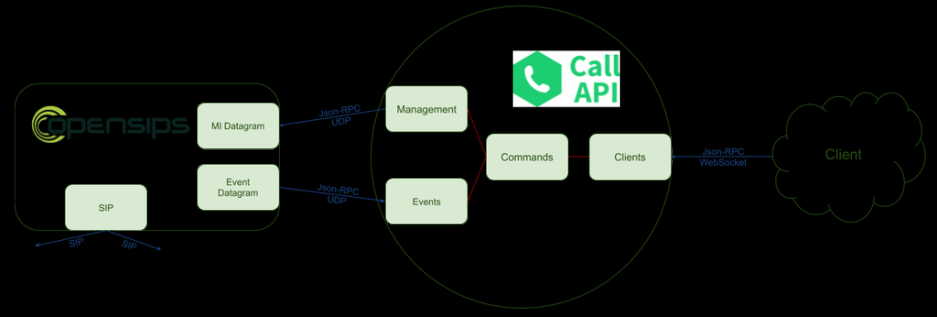看来OpenSIPS的目标已经不仅仅局限于做代理了,而是想做呼叫控制。
原文:https://blog.opensips.org/2020/06/11/calls-management-using-the-new-call-api-tool/
The new Call API project consists of a standalone server able to serve a set of API commands that can be used to control SIP calls (such as start a new call, put a call on hold, transfer it to a different destination, etc.). In order to provide high performance throughput, the server has been developed in Go programming language, and provides a WebSocket interface that is able to handle Json-RPC 2.0 requests and notifies.Although it runs as a standalone daemon able to control calls, it does not directly interact with SIP calls, but just communicates with a SIP proxy that actually provides the SIP stack and intermediates the calls. The first release of the Call API is using OpenSIPS for this purposes, but this is a loose requirement – in the future other SIP stacks can be used, with the appropriate connectors.
Architecture
In terms of architecture, the new Call API tool consists of multiple units, the most important ones being:
- Clients interface – this unit is responsible for receiving Json-RPC requests over WebSocket from clients and pass them to the Commands unit
- Management interface – this is the unit that communicates with the SIP proxy in order to instruct what needs to be done
- Event interface – listens for event from the SIP proxy and passes them to the Commands unit
- Commands unit – this is the unit that implements the commands logic, ensuring the interaction between all the above interfaces.
Communication between these units is done asynchronous using go-routines. Below you can find a diagram that shows how all these units are interconnected

Demo
Below you can watch a video that shows how you can use some of the features the Call API tool provides, such as:
- Start a call between two participants
- Put the call on hold
- Resume the call from hold
- Transfer a call to a different destination
- Terminate an ongoing call
Enjoy watching!